Generally, when playing dynasty fantasy football, we know the archetypes. Running backs burn hot and bright. Quarterbacks can go forever. Tight ends develop late. Wide receivers? Well, they’re the hardest of the four to pin down.
In recent pieces, I’ve looked at the aging tendencies of the top fantasy quarterbacks and running backs for dynasty purposes, and while things went more or less according to expectations, there were some surprises. For example, over the last 12 years a 27-year-old top-12 quarterback is more than twice as likely to do it again as a 26-year-old. Or at running back, 2018 gave us 13 first-time entrants in the top-24, easily the biggest number over the last 12 years — it’s even more of a young man’s game than ever. So even if overall results meet our general expectations, looking at age trends by position can be illuminating for our dynasty preparation.
Today, we look at wide receivers.
(All ages are the player’s age as of Dec. 31 of the given season)
Age range
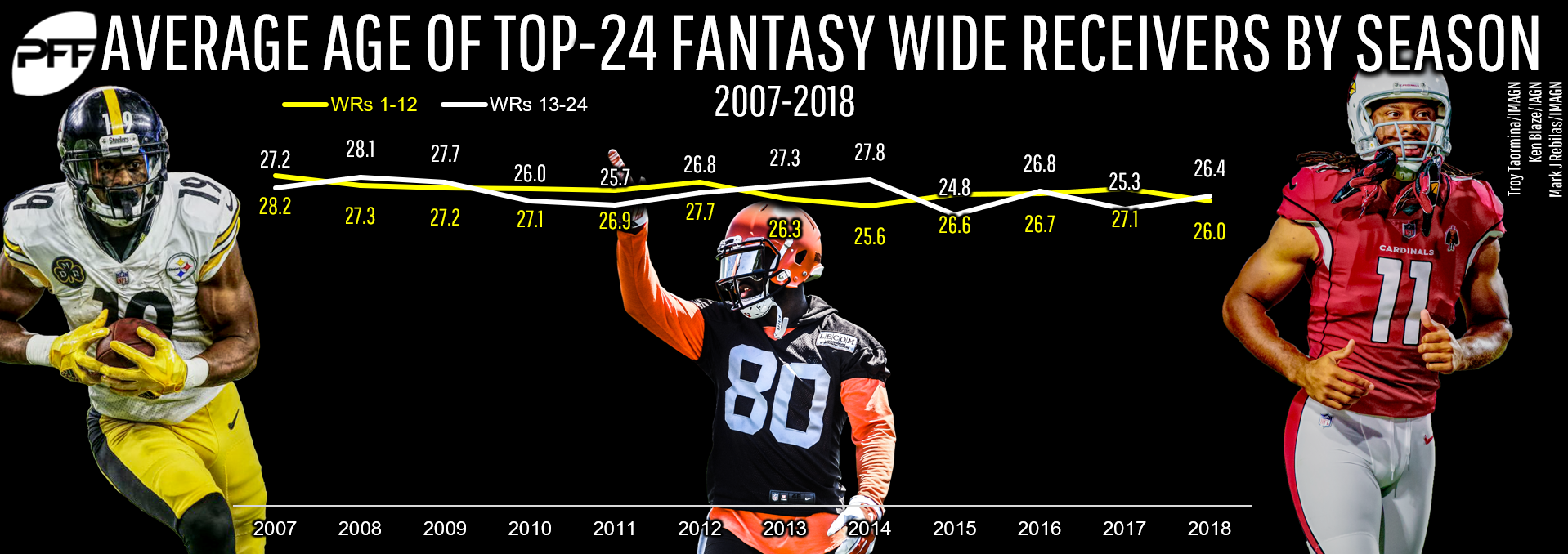
Overall, the top-24 PPR wide receivers have averaged 26.8 years of age over the last 12 years. And unlike running back, where the first 12 were pretty regularly younger than the next 12, there was no real tendency at wide receiver — WRs1-12 were older than WRs13-24 half the time and younger the other half, with only a 2.3-year gap in 2014 coming in at two years of difference or more.
The main takeaway? Over a grand scale, the top-24 WRs are older than the top-24 RBs, but the gap (26.8 years to 25.7) isn’t actually as big as you might guess from the way we talk about such things.
Remember earlier, when I noted that the younger running backs were popping more in recent years? That is … not so true at wide receiver.
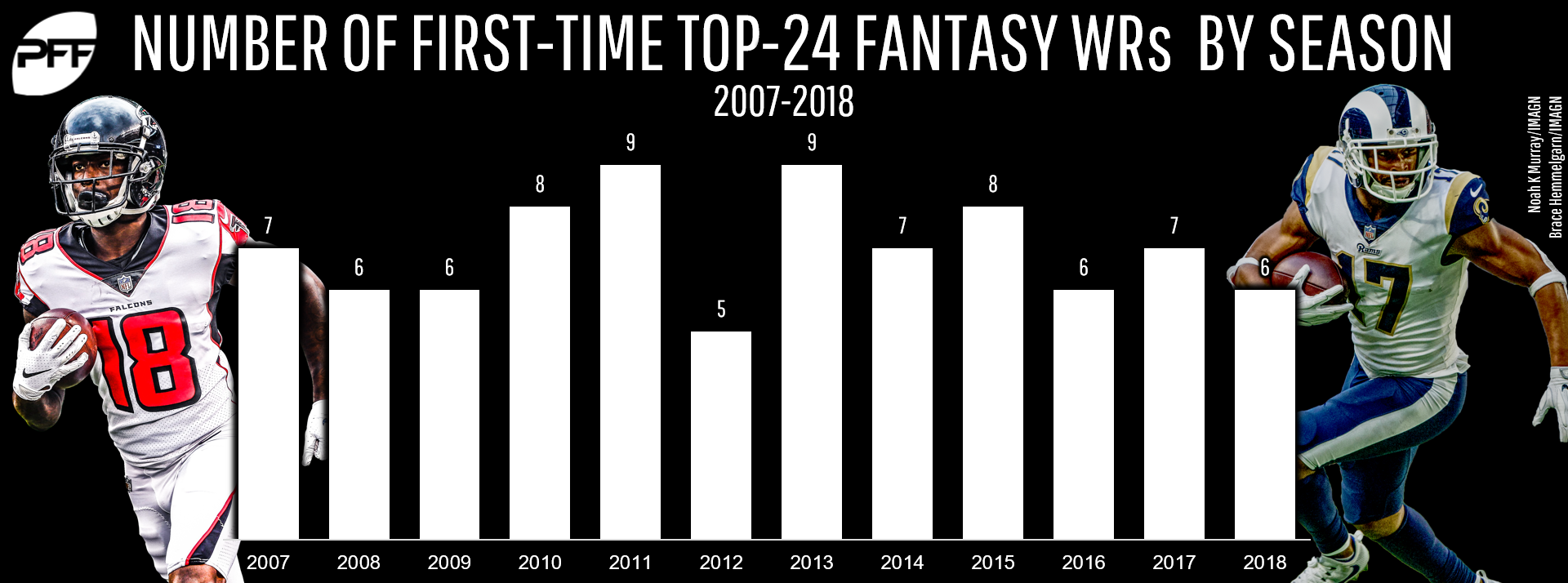
Only once in the last 12 years (2012) has there been fewer first-time top-24 receivers than the six there were last year. And adding to that, the “pops” are less significant than they have been in the past as well.

The way things have gone in recent years, if you want a clear-cut WR1, you’re best off opting for a guy who has been there at least once before. With that in mind, let’s look at how frequently each age made the top-24.
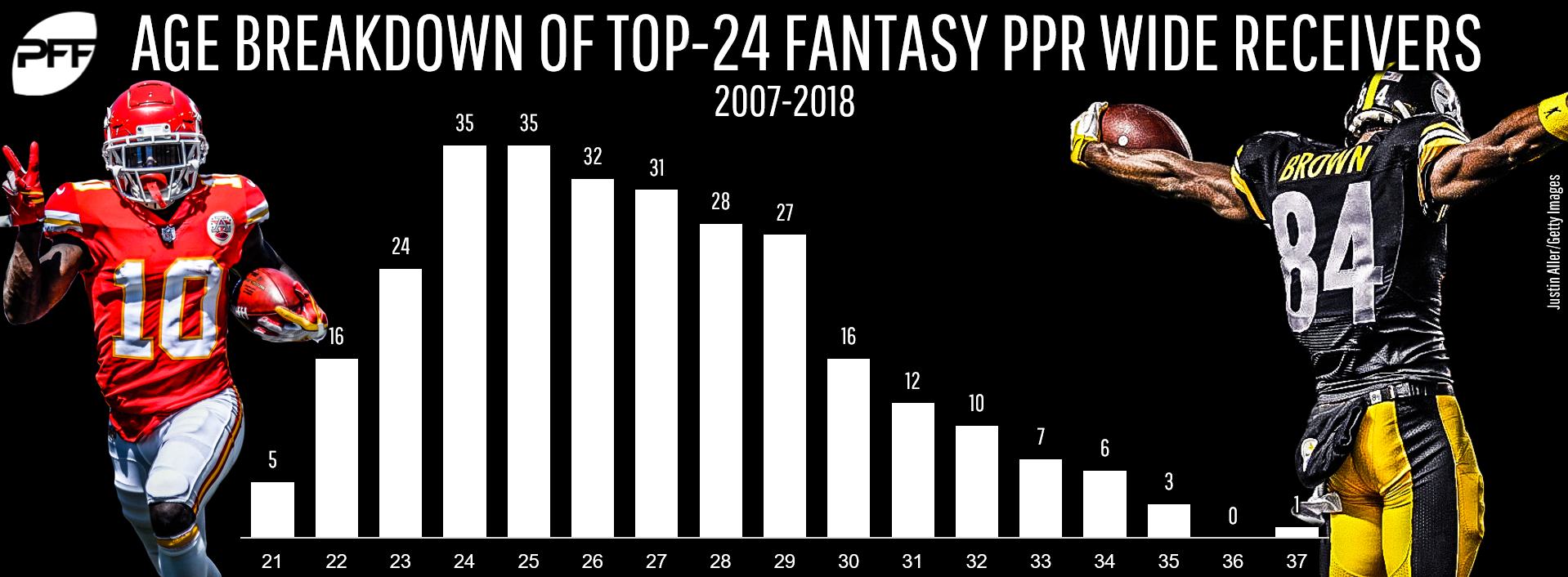
You know what this graph looks like? It looks like the top-24 running backs. Wide receivers have a slightly longer peak — stretching to 29 instead of 27/28 — and a longer tail end buoyed almost entirely by Terrell Owens, but if you take Owens out of the information altogether and obscured the position, you could just about put these up interchangeably.
When do they first develop?
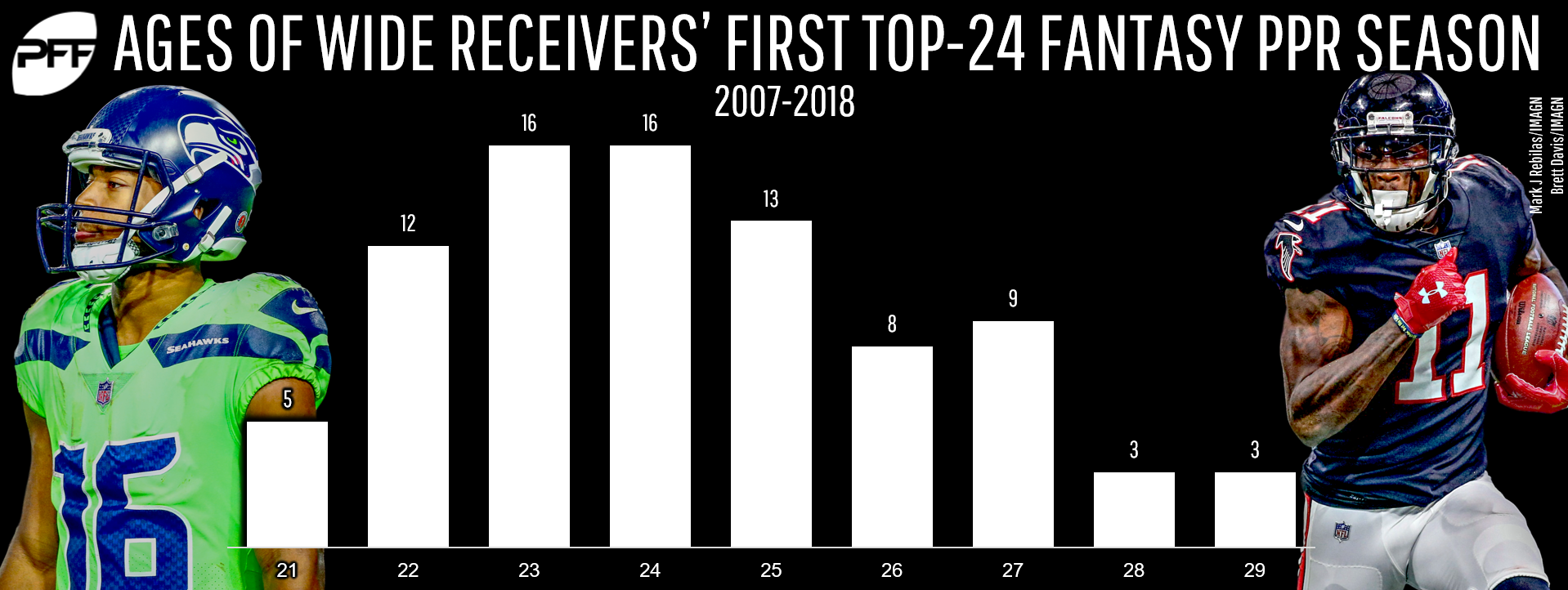
The biggest lesson I’ve learned from this particular piece of research across all three positions is that there’s a pretty clear cutoff after which a player who has never made the top levels at his position just isn’t very likely to do so. For wide receivers, there are maybe two. Out of 85 first-time top-24 wide receivers in the last 12 years, 62 (73%) have done so by age 25, while 79 (93%) have done it by 27. A 24- or 25-year-old might still have another level he can reach. A 28-year-old? Don’t bet on a breakout.
Six wide receivers in the last 12 years have become top-24 performers at age 28 or later. They were:
- Nate Washington (WR15) in 2011 at age 28;
- James Jones (WR17) in 2012 at age 28;
- Brandon LaFell (WR22) in 2014 at age 28;
- Kevin Curtis (WR17) in 2007 at age 29;
- Brandon Lloyd (WR2) in 2010 at age 29;
- Harry Douglas (WR22) in 2013 at age 29
Note that of those five, only Lloyd reached a ceiling of higher than 15th at the position, and he’s the only one of the six who ever did it a second time (and he didn’t reach a third).
Staying power
You saw above that the older receivers who first reach the top-24 don’t manage to do it again very often. But how do the trends look at lower ages? Can we glean anything from guys who make the top-24 at age 22 versus age 26?
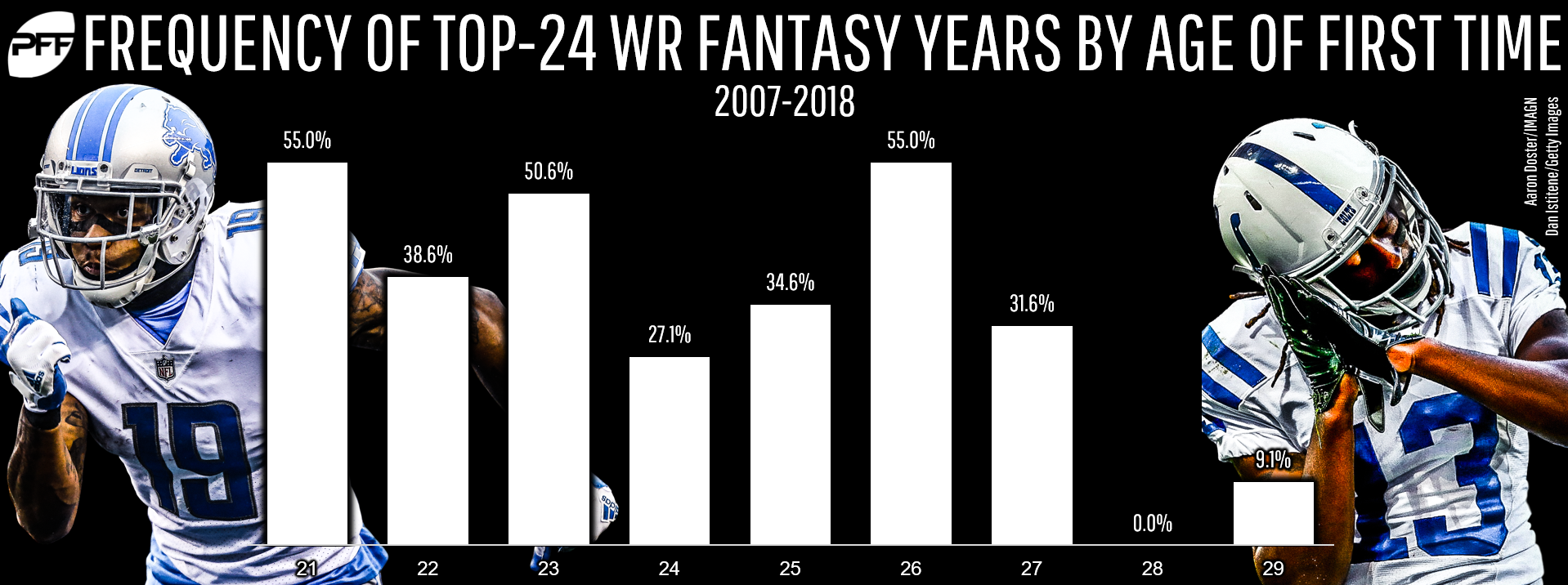
… Not really. Ultimately, you have about a 40% chance each season of returning to the top-24 no matter when you first got there, so long as you were 27 or younger when you started. Not every piece of research has to yield staggering results.
Continuing the theme, next I looked at guys who had put up a top-24 season at any age. Could we glean anything from how younger top-24 guys aged as compared to older ones?
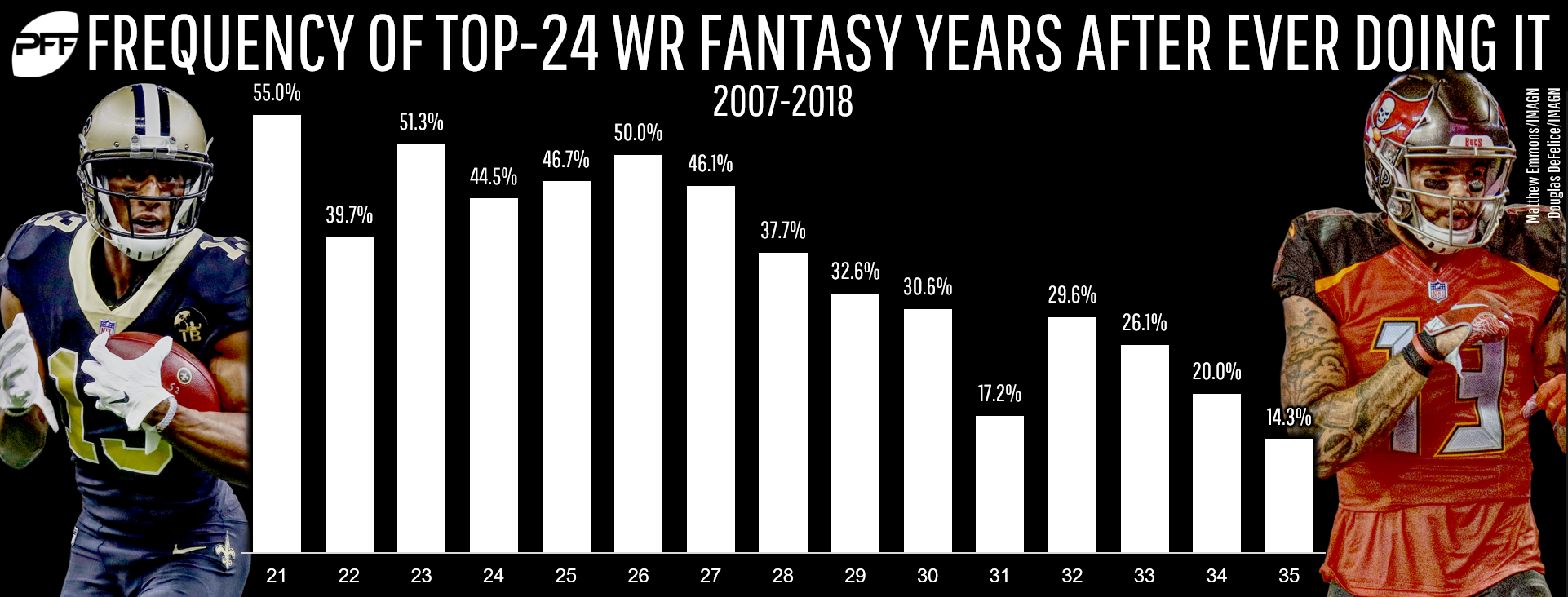
Nothing too surprising here in the aggregate, except one thing — the percentages are low. For running backs, the youngest backs, the 21-year-olds, went on to put up top-24 seasons about two-thirds of the seasons they played. But receiver tops out at 55% and hovers below half for a lot of it. And honestly, my theory about that is that it is a testament to wide receiver longevity, not an indictment. When a running back is washed, he stops putting up top-24 seasons and his career basically ends. When a receiver is washed, though, he continues to play and play and play, meaning he’s putting up more of those bad seasons than his running back counterpart.
Current samples
As mentioned above, 2018 saw six first-time top-24 receivers. They range from first-round picks and high pedigrees (Calvin Ridley, Kenny Golladay) to late bloomers (Robert Woods, Tyler Boyd, Tyler Lockett), to under-the-radar veterans (Adam Humphries). If you can find a throughline connecting those six in any meaningful way, congratulations.
Best dynasty picks
I could list the top dynasty picks at wide receiver, but it’s not that illuminating to say “Odell Beckham Jr. and Michael Thomas are good.” Rather, here are some interesting tidbits that could make some of these guys better picks than you might think of at first.
- There have been five receivers put up a top-24 season in the last 12 years at age 21. Four of them are (a) still active and (b) put up top-24 years in 2018 as well. The only player who had a top-24 season longer back than our active crew is Percy Harvin, who finished as WR24 in 2009, stayed on the list in 2010 and 2011, then hung around five ore seasons without ever recapturing that glory.
- Keenan Allen debuted on the list as a 2014 rookie, then missed for three straight seasons largely because of injury before returning to the upper tier in 2017 and 2018. As a result, who feels like a seasoned veteran, is only entering his age-27 season. He’s barely a year older than Cooper Kupp — and yes, Kupp is often the posterboy for this sort of age comparison, but it does illustrate the point that Allen is surprisingly young.
- Amari Cooper’s career has been confounding. You could argue he’s actually been a disappointment all four years of his career despite finishing as a top-24 receiver in three of them (as a 21-, 22-, and 24-year-old). It’s hard to know what to make of that, except that … no, it’s just hard to know what to make of that.
- JuJu Smith-Schuster has started his career like gangbusters and, for better or worse, seems likely to be the Steelers’ WR1 next year. He could set a modern record if he can start his career with six straight top-24 seasons from age 21 … assuming someone else’s streak ends. Who? Well…
- Mike Evans was one of the exemplary 2014 first-round crop of receivers (along with Sammy Watkins, Odell Beckham Jr., Brandin Cooks, and, uh, Kelvin Benjamin), and he was the youngest of that group. He’s also the only player from that group (or any time in the last 12 years, or possibly ever) to be a top-24 fantasy receiver in each of his first five NFL seasons. Nobody else in the last 12 years has even done it in his first four years. I’m not saying Mike Evans should be your WR1 in dynasty — he shouldn’t — but there isn’t much more stability out there to be found.
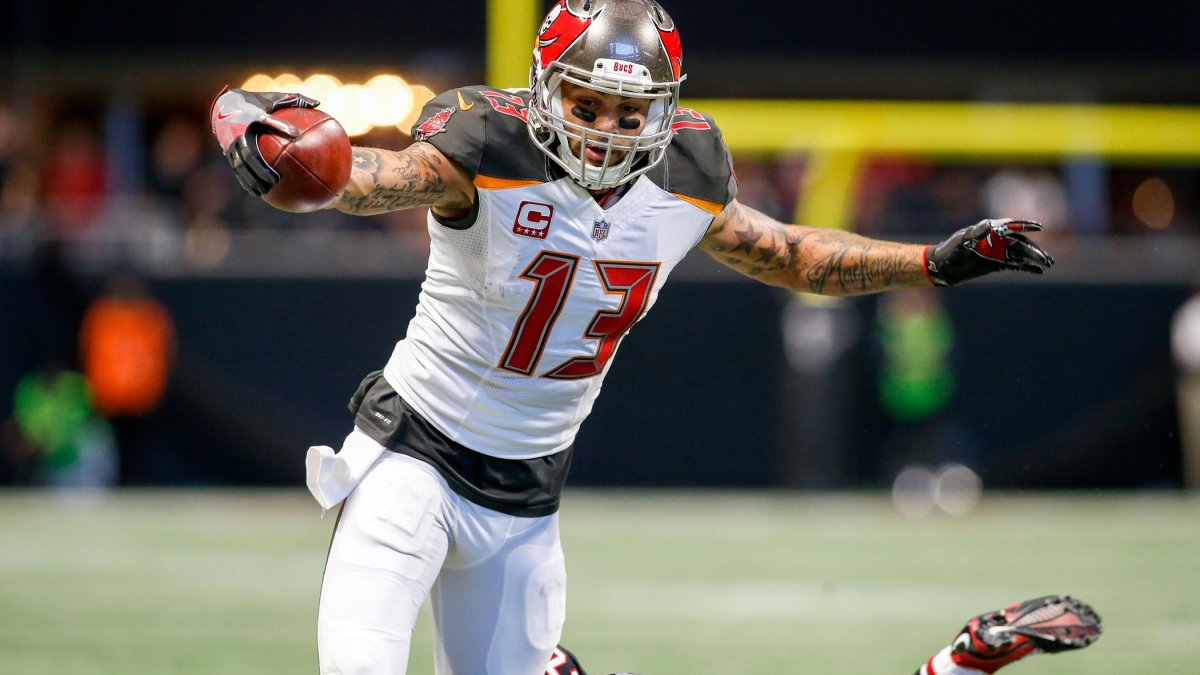


 © 2025 PFF - all rights reserved.
© 2025 PFF - all rights reserved.